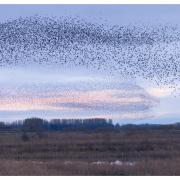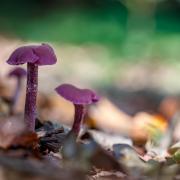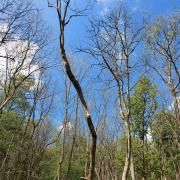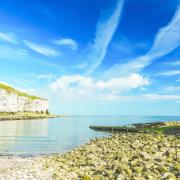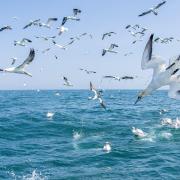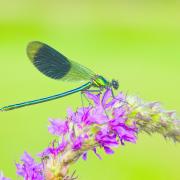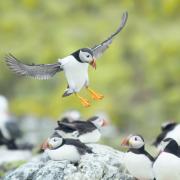Autumn is time for an incredible – and challenging – journey, and we can all get a front-row seat this month, as Yorkshire Wildlife Trust’s Tom Marshall discovers.

Far away from hazy summer days beside a sun-drenched lake, my legs still dangle over a rock, this time covered in plenty of layers of socks for a bracing autumn afternoon.
There’s dampness in the air and occasional gloopy drops of water finally let go from the tips of leaves above me, remnants of the rain a few hours earlier. Far from being an unwelcome element of the forecast, the previous downpour is just what was needed to make my trip all the more worthwhile, creating as it has, a river in spate and tumbling with relentless foaming and bubbling waterfalls. And these are just the conditions needed for a chance to encounter what I’ve travelled to see.
I’m in the heart of the Yorkshire Dales, in a landscape of a thousand postcards; surrounded by woodland turning firey-red and orange, a humpback bridge crumbling with old-age grace and dignity, and in the distance a mill harking at a past harnessing the power of the river I’m sitting beside.
The wait can be short – perhaps a few minutes after my arrival, or somewhat longer as your attention wavers and eyes gaze instead towards a hungry jay or woodpecker. Then – and always without warning – a silvery flash from the torrent before me as an Atlantic salmon fires itself torpedo-like out of the bubbling river and a split second later vanishes behind the curtain of falling water. My hunch was right, the salmon run has begun.

One of nature’s most impressive journeys, many of us associate this phenomenon with the vast rivers of Alaska or Canada, backdrop to wildlife documentaries fronted by hungry bears. While these hairy diners certainly won’t be joining me today in the uplands of Yorkshire, the monumental endurance efforts of their prey and momentary insight into their lifecycle is still one story we can enjoy in the county.
This epic journey is of course, the final chapter for the salmon and a pilgrimage home to the very first days of their existence, among the shallow shingle bottoms of our rivers.
How long ago that was can vary, perhaps just a year or two, or for some as much as four. But today’s energy-sapping efforts to climb countless waterfalls have a hard-wired end-game in sight, to aid spawning for a new generation – a decision that may cost the ultimate price.
Years previously, these impressive fish were just tiny eggs buried in riverbed gravels, gently embraced under the stones by a carefully placed swoosh of their mother’s tail.

After a winter safe from turbulent waters, the warmth of spring encourages them to begin life as alevins, remaining in the sanctuary of the gravel for around a month or more, before tentatively emerging as fry.
These fry soon become parr, and take on an extended period of time among our freshwater rivers, feeding on invertebrates – and hopefully successfully avoiding the fly fisherman’s lure.
As the spring of their second, third or fourth year swings around, the parr become smolts and head to sea, signalling the most unusual stage in their lives – and perhaps representing the beginning of their final chapter as salmon.
Now a striking silvery shimmer, our oceans host a remarkable phase in the salmon’s existence as they become not a freshwater but saltwater species, often venturing long distances to rich and productive feeding grounds where bite-size prey no longer cut it in favour of krill, sand eels and herring.

Whether at sea for just a year before their return (grilse) or so-called multi-sea salmon that may have been globe-trotting for much longer, the urge to return to the place of their birth finds salmon once again heading back into our rivers in early autumn – this time against an unforgiving downstream flow.
Somewhat astonishingly, this battle against the odds is undertaken on what may end up being an empty stomach; in that the salmon do not feed again once they re-enter our river systems.
So begins weeks of trials that may include the relatively calm waters of our estuaries, but soon becomes a tougher challenge of our lowland rivers – under the watchful eye of herons, otters or perhaps even an unseasonal osprey.
If the sets of whiskered jaws, sharp beaks or a too-good-to-resist flies have been successfully dodged, then white water remains the final hurdle to overcome.
Probably capable of leaping three or four times their own length, positioning and timing is key for each attempt at these walls of water, with fish often seen gathering in the calmer pools below, like athletes warming up for the task ahead.
For those that successfully navigate this gauntlet of Mother Nature’s doing, the final act of spawning will likely take place with what little energy remains. It’s perhaps little wonder then that scientists estimate that fewer than one in 20 returning salmon will make it back to the Atlantic and repeat the story again the following season.
With such a dramatic life story, and one which we may only glimpse briefly for a few valuable but awe inspiring seconds, maybe we should all grab our hat and a riverside seat this month – and give them a round of applause.
Where and how to find leaping salmon
The salmon run typically starts in October and runs through November, with your best chance on an overcast day, ideally after recent heavy rains that put the river into a fast flow or ‘spate’. There’s some suggestion that later in the afternoon can be a good time too, however the run can take place at any time during the day.
Stainforth Force, River Ribble, Settle
Park in the village and see the signs for the best route to the river, with the primary viewing areas at Stainforth Force, just downstream of the bridge. Take care on the rocks when slippery. The weir further down the river may also offer a chance to see salmon, not least from the bridge, and the salmon ‘ladders’ installed at the edge to allow fish to make progress. Please note – there are no parking opportunities at the river itself.
River Wharfe, Otley Weir
Accessed through Wharfe Meadows Park, Otley, salmon may join the more familiar brown trout for the big jump on this gently sloping but fast-flowing weir.
Trout and about
A number of other Yorkshire rivers have also reported salmon leaps in recent years, such as the Don at Aldwarke in Rotherham, while trout are a more common feature in the county’s waterways, including on the Esk near Whitby. River managers including the Environment Agency are hoping to encourage the return of salmon by increasing the use of fish ‘passes’ or ladders, beneficial both to fish and other threatened species such as eels.












